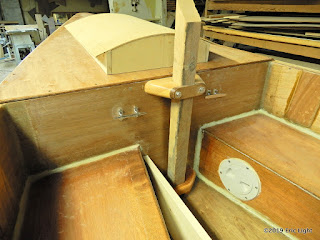I used two layers of 1½-oz mat to make the hatch cover, with an extra two layers around the vertical sides. It came out of the mold without a problem:
The green stuff is the Partall mold release stuff. Whatever doesn't peel off dissolves instantly in water. The white thing sitting in the mold is a piece of high density plastic that I made into a wedge/pry bar. What really popped the part out of the mold after I loosened it with that tool was compressed air. Magic!
So, here it is:
It was too tight at first to go on, so I ground off some of the wood around the perimeter of the deck opening.
I was planning to cut it down so it wasn't so high, but it's shaped wider at the bottom to facilitate it coming out of the mold, so cutting material off the bottom would make it fit tighter yet.
So I'm not totally happy with it and may just make a flat ply cover same as the after one. We'll see. It may grow on me.?
Meanwhile, I've decided I don't like the tiller I carved out of the two-by-four, so I designed one to be made of layers of plywood, since I still have a fair amount of it left over:
I'm making the bottom version. The grey vertical bit is the pivot bolt that attaches it to the rudder head. The space aft of it on one side is for the downhaul line that will keep the rudder blade down. I realized that I had to bring the line around that neutral point so that I could lift the tiller without changing the tension on the downhaul line.
The new tiller has a nicely curved profile:
Something like that, anyway. We'll see how it ends up. It's a lot of fussy drawing and sawing to get all the pieces right. A CNC cutter would be nice, but an extravagance for this endeavour.
It's too cold in the shop right now (down to 3 and 4 degrees C at night) to use Titebond (which needs 7º, they say), so I'm gluing the tiller up in my bathroom at home. I don't want a glue failure at sea, that's for sure!
Heavy things I found around the house. The black container was from shipping olives. It's my emergency water supply for when "the big one" hits the west coast. The wedge is keeping it from tipping over.




















